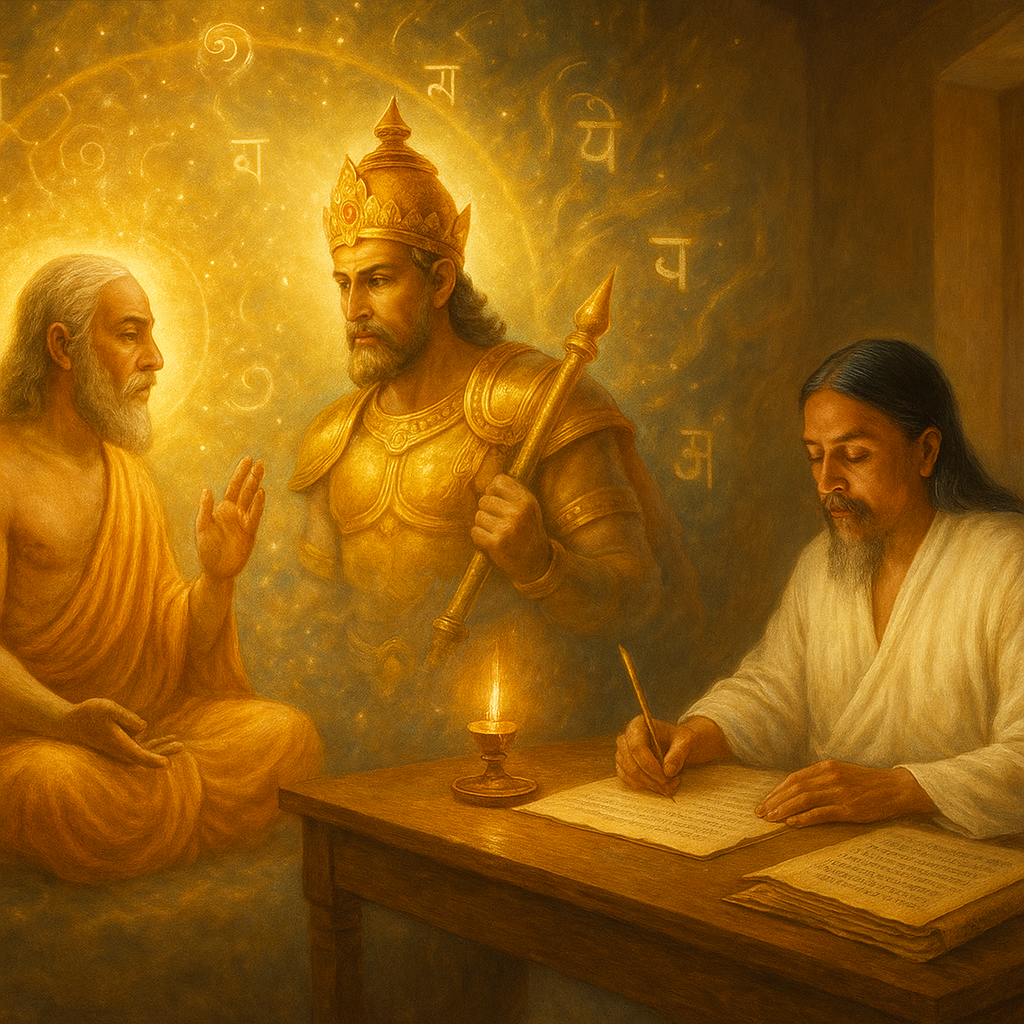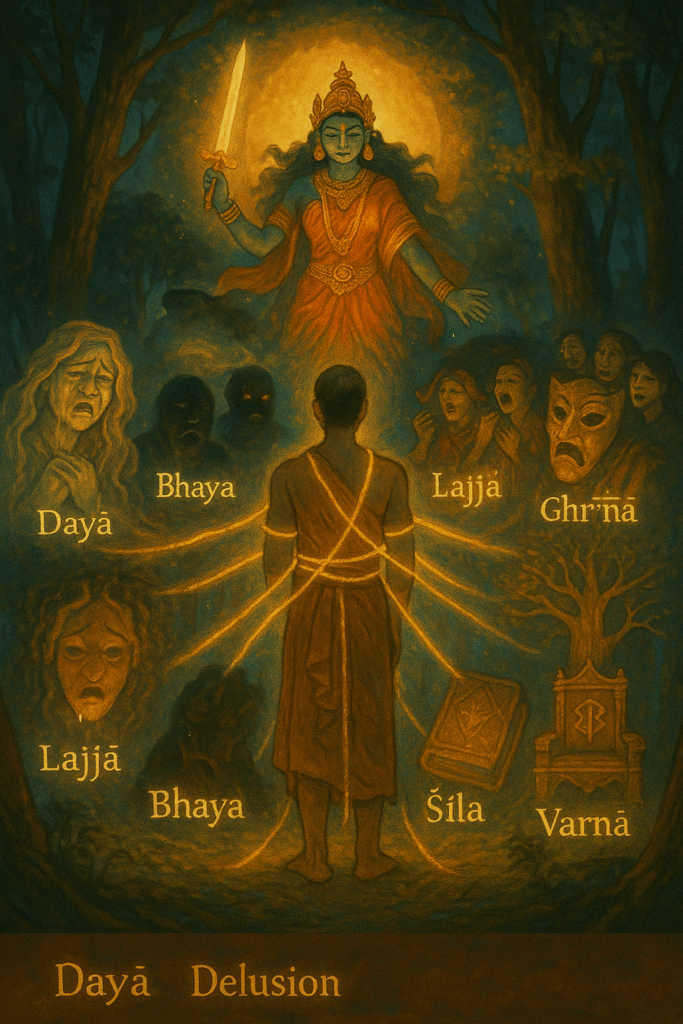No Fear of Harm in These Practices
The practice of mantras follows a specific discipline and methodology. To attain success, one must perform daily recitations, prescribed rituals, anushṭhāna (intensive spiritual discipline), and purashcaraṇa (repetitive chanting with austerities) with proper adherence to the rules. In general, an improperly conducted ritual may prove harmful to the practitioner, and instead of yielding benefits, it might bring unfavorable consequences.
There are numerous instances where an individual engaged in mantra sādhana, worship of deities, yogic exercises, or tāntrika rituals—but due to mistakes in methodology, or interruption in the practice, the practitioner had to face severe misfortunes. Such examples are found in historical and scriptural accounts.
For instance, in the Vedic legend of Vṛtra and Indra, mispronunciation of Vedic mantras led to disastrous consequences. The same applies to all Vedic mantras, including Gāyatrī, which should be chanted correctly with precise phonetics and proper intonation. A methodically performed anushṭhāna yields swift success and excellent results.
However, unlike other mantras, Gāyatrī has a unique safeguard—it never causes harm, even if mistakes are made in its practice.
Just as a compassionate and wise mother always seeks the well-being of her children, Veda-Mātā (the Divine Mother Gāyatrī) ensures the spiritual progress of her devotees. A child might unknowingly offend or err in honoring its mother, yet the mother never harbors resentment or inflicts harm. Even when children act contrary to her wishes, she forgives them with boundless compassion.
If an ordinary mother exhibits such immense mercy and patience, how much more merciful would Veda-Mātā, the divine embodiment of wisdom and virtue, be towards her devotees?
The moment she sees sincere faith and devotion in a devotee’s heart, her grace overflows, and any minor mistakes or ritualistic errors dissolve like a straw swept away in the current of her divine compassion.
Bhagavad Gītā’s Assurance of Fearlessness in Righteous Practice
Lord Kṛṣṇa assures in the Bhagavad Gītā (2.40):
“Ne’hābhikrama-nāśo’sti pratyavāyo na vidyate,
svalpam apyasya dharmasya trāyate mahato bhayāt.”
📖 Translation:
“In this righteous endeavor, there is no loss of effort nor any adverse reaction. Even a small step taken on this path protects one from great fears.”
This verse emphasizes that any effort made towards a righteous act (satkarma) never goes in vain. Even if one’s practice is interrupted, it does not yield negative consequences. The benefits of spiritual effort continue accumulating and protect the seeker from great dangers.
Similarly, Gāyatrī Sādhana is a pure and sattvic (virtuous) spiritual pursuit. Once initiated, it naturally attracts the mind towards it. Even if a practitioner discontinues the practice for some reason, the urge to resume it arises again and again—just as a person who has once tasted a delicious nectar craves it repeatedly.
Gāyatrī Sādhana is like spiritual nourishment, which the soul constantly yearns for. If errors occur in practice, they do not result in harm. The only possible outcome of mistakes could be:
- A reduced level of benefit, or
- At worst, no effect at all.
There is no risk of calamity, disaster, or negative consequences.
Even the smallest sincere effort in this path yields immense benefits and grants freedom from fears that might otherwise be difficult to overcome.
Nārada’s Inquiry and Lord Nārāyaṇa’s Response in Bhāgavata Purāṇa
In the twelfth canto of the Bhāgavata Purāṇa, Nārada Muni once asked Lord Nārāyaṇa:
“Please reveal a method that even ordinary beings can practice with ease and that would ensure divine grace for their welfare.”
Nārada’s concern was valid—most spiritual disciplines require strict rules, renunciation, and intense penance, making them difficult for the common person to follow.
📖 Lord Nārāyaṇa replied:
“O Nārada! Even if a person does not perform other rituals, if they have unwavering faith in Gāyatrī, they make their life blessed. Those who offer libations (arghya) at sunrise and sunset and recite Gāyatrī 3,000 times daily become worthy of worship even by the gods.”
The scriptures state:
“Devo bhūtvā devaṁ yajet”
(One must elevate themselves to a divine state before worshiping the divine.)
However, if someone cannot perform the detailed ritualistic observances, but instead meditates on the divine essence of Gāyatrī with a pure heart, that too is sufficient for immense spiritual progress.
📌 Even mastering just one syllable of the Gāyatrī mantra can elevate a devotee to a state where they attain divine stature, comparable to Viṣṇu, Śiva, Brahmā, Sūrya, Candra, and Agni.
📌 A disciplined Gāyatrī practitioner attains all spiritual perfections (siddhis) through this single mantra. There is no doubt about this truth.
📌 Thus, in this age, Gāyatrī Sādhana—being the purest and most selfless practice—is the highest spiritual pursuit.
Practicing Gāyatrī Sādhana Without Fear
With these reflections, Gāyatrī seekers should discard all fears and doubts and practice fearlessly, with devotion.
Gāyatrī is not an ordinary mystical weapon that requires elaborate technicalities for activation. Instead, she is like a loving mother—one does not need cunning methods to approach her; a child simply calls ‘Mother!’ with sincerity, and she comes running.
A calf does not need to use tricks to find its mother—it simply calls out, and the mother cow responds with love and feeds it abundantly.
📌 Similarly, all that is required to invoke Gāyatrī’s grace is a sincere heart and unwavering faith.
📌 We must strive to follow the scriptural guidelines to the best of our ability. However, just as a mother forgives her child’s innocent mistakes, Veda-Mātā forgives minor errors in practice—so long as the devotion and sincerity are genuine.
📌 One must never abandon Gāyatrī Sādhana due to fear of making mistakes.
📌 Even an imperfect effort in her worship is infinitely better than neglecting it altogether.
Conclusion: Embracing Gāyatrī Without Hesitation
- The Divine Mother Gāyatrī does not punish her children for unintentional mistakes.
- Unlike certain esoteric practices that can backfire if done incorrectly, Gāyatrī only brings blessings.
- One should approach her with faith and devotion, not with fear or doubt.
Thus, let us call upon Veda-Mātā with pure hearts, absorb her divine nectar, and embrace the boundless grace she showers upon her sincere devotees.


